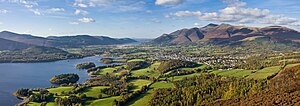Walking is one of the most popular outdoor recreational activities in the United Kingdom,[1] and within England and Wales there is a comprehensive network of rights of way that permits access to the countryside. Furthermore, access to much uncultivated and unenclosed land has opened up since the enactment of the Countryside and Rights of Way Act 2000. In Scotland the ancient tradition of universal access to land was formally codified under the Land Reform (Scotland) Act 2003.[2] In Northern Ireland, however, there are few rights of way, or other access to land.
Walking is used in the United Kingdom to describe a range of activity, from a walk in the park to trekking in the Alps. The word "hiking" is used in the UK, but less often than walking; the word rambling (akin to roam[3]) is also used, and the main organisation that supports walking is called The Ramblers. Walking in mountainous areas in the UK is called hillwalking, or in Northern England, including the Lake District and Yorkshire Dales, fellwalking, from the dialect word fell for high, uncultivated land. Mountain walking can sometimes involve scrambling.


- ^ Ramblers Association website: Walking Facts and Figures[dead link]
- ^ "Enjoy Scotland's Outdoors" (PDF). Scottish Government. Retrieved 17 July 2018.
- ^ "Ramble". www.etymonline.com.
